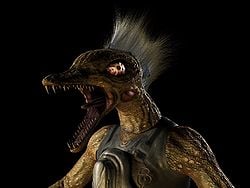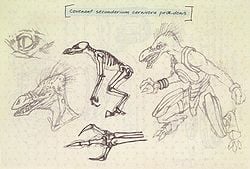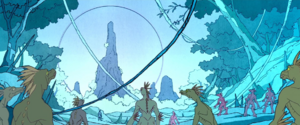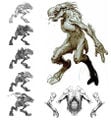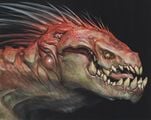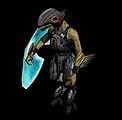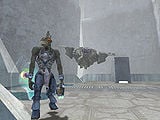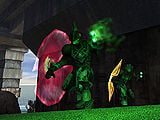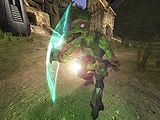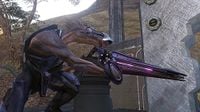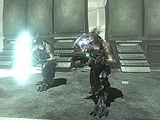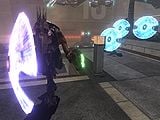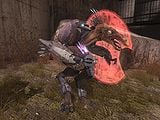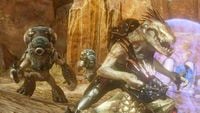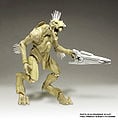Kig-Yar: Difference between revisions
From Halopedia, the Halo wiki
Sith Venator (talk | contribs) |
Imrane-117 (talk | contribs) m (→Subtypes: Easier to distinguish their names in the paragraphs) |
||
| Line 74: | Line 74: | ||
The Kig-Yar species is represented by at least three morphologically distinct subtypes. These include the mainstream "Jackals" of [[Ruuht]],<ref>[https://forums.halowaypoint.com/yaf_postsm2988575_Catalog-Interaction.aspx#post2988575 '''Halo Waypoint''': ''Catalog Interaction - Page 39'']</ref> the notably reptilian Jackals of [[Ibie'sh]], and the more physically robust (and more avian) "Skirmishers" of [[T'vao]]. The morphological variation among the Kig-Yar likely represents divergent evolution in response to varied environments on prehistoric Eayn and, subsequently, their various interplanetary colony worlds.<ref>'''[[Halo Encyclopedia]]''' (2011), ''pages 56-57''</ref><ref>[http://halo.xbox.com/en-us#/intel/theuniverse/characters/video/the-jackals/24dc0ecc-8cf0-473a-aae3-266fe6019d61?filter=all '''Halo Waypoint''': ''The Jackals'']</ref> | The Kig-Yar species is represented by at least three morphologically distinct subtypes. These include the mainstream "Jackals" of [[Ruuht]],<ref>[https://forums.halowaypoint.com/yaf_postsm2988575_Catalog-Interaction.aspx#post2988575 '''Halo Waypoint''': ''Catalog Interaction - Page 39'']</ref> the notably reptilian Jackals of [[Ibie'sh]], and the more physically robust (and more avian) "Skirmishers" of [[T'vao]]. The morphological variation among the Kig-Yar likely represents divergent evolution in response to varied environments on prehistoric Eayn and, subsequently, their various interplanetary colony worlds.<ref>'''[[Halo Encyclopedia]]''' (2011), ''pages 56-57''</ref><ref>[http://halo.xbox.com/en-us#/intel/theuniverse/characters/video/the-jackals/24dc0ecc-8cf0-473a-aae3-266fe6019d61?filter=all '''Halo Waypoint''': ''The Jackals'']</ref> | ||
Jackals from | Jackals from Ruuht—'''Ruuhtians'''—typically exhibit light brown, tan, or sallow skin tones, with green skin appearing less often;<ref>'''Halo Legends''' - ''Origins'' and ''Homecoming''</ref><ref name="Bulletin">[https://blogs.halowaypoint.com/en-us/blogs/headlines/posts/the-halo-bulletin-9-24-14 '''Halo Waypoint''': The Halo Bulletin: 9.24.14'']</ref> flexible quills on the head and forearms among males, with calloused plates among females; and elongated heads with bulbous eyes and beak-like snouts. The most common head morphology involves a downward-sloping snout,<ref>'''Halo 3''', '''Halo: Reach''', and related media</ref> though specimens with straight snouts are also common.<ref>'''Halo 2'''</ref><ref>''Halo: Uprising''</ref><ref group="note">In ''Halo: Combat Evolved'', Jackals have squat heads, very bulbous eyes, baleen-like teeth, and dark green or reddish orange skin. This design has not been featured in any subsequent media and has seemingly been retconned from existence by ''Halo: Combat Evolved Anniversary''. ''Anniversary'' instead uses the ''Halo: Reach'' design, though it is scaled down to the original Jackals' smaller frame, giving the Jackals squat heads and much shorter necks.</ref> | ||
Jackals hailing from the continent of Ibie' | Jackals hailing from the continent of Ibie'sh—'''Ibie’shans'''—have the same body structure as most of their kin, but their heads are far more muscular and reptilian in appearance, with shorter snouts and underbites.<ref name="Bulletin"/><ref>'''Halo 4'''</ref><ref name="VIS">'''[[Halo 4: The Essential Visual Guide]]'''</ref> These Jackals also differ from the more commonly seen variety in having reddish plumes and yellow-tinted eyes. Whether this is a natural or artificial variation is unknown. Ibie’shans have served in the Covenant military as early as [[2526]]<ref>'''Halo 4: Forward Unto Dawn'''</ref> and now constitute the majority of Kig-Yar in [[Jul 'Mdama's Covenant faction|Jul 'Mdama's Covenant]]. | ||
T'vaoans, commonly known as Skirmishers, originated from the Kig-Yar colony [[asteroid]] of T'vao.<ref>[[Halopedia:Letter - Re:Mortal Dictata Question]]</ref><ref>'''[[Halo: Mortal Dictata]]''', ''Chapter 2''</ref> They have darker skin and stockier, squared heads with small yellow eyes. They also have more beak-like mouths and bony facial coverings. Skirmishers have true feathers on their heads and arms, unlike the Jackals' quills. Like Jackals, Skirmishers have sharp talons on their hands and feet. While both subspecies are quite agile, Skirmishers are capable of sprinting at great speeds and leaping long distances. Male Kig-Yar from T'vao had much heavier upper body plumage than other Kig-Yar. Females from T'vao had a ruff of feathers on their heads and necks instead of scales.<ref>'''Halo: Mortal Dictata''', ''Chapter 3''</ref> | '''T'vaoans''', commonly known as Skirmishers, originated from the Kig-Yar colony [[asteroid]] of T'vao.<ref>[[Halopedia:Letter - Re:Mortal Dictata Question]]</ref><ref>'''[[Halo: Mortal Dictata]]''', ''Chapter 2''</ref> They have darker skin and stockier, squared heads with small yellow eyes. They also have more beak-like mouths and bony facial coverings. Skirmishers have true feathers on their heads and arms, unlike the Jackals' quills. Like Jackals, Skirmishers have sharp talons on their hands and feet. While both subspecies are quite agile, Skirmishers are capable of sprinting at great speeds and leaping long distances. Male Kig-Yar from T'vao had much heavier upper body plumage than other Kig-Yar. Females from T'vao had a ruff of feathers on their heads and necks instead of scales.<ref>'''Halo: Mortal Dictata''', ''Chapter 3''</ref> | ||
==Culture== | ==Culture== | ||
Revision as of 19:12, November 16, 2014
- "Jackals may be superior marksmen and they're very sneaky, but that doesn't make them excellent snipers — they’re a little too bloodthirsty for that."
- — Anonymous UNSCDF serviceman
The Kig-Yar (sometimes rendered as "Kig-yar"; Forerunner designation: Perosus latrunculus, Latin for "hateful bandit";[1] human designation: Covenant secundarium carnivora prœdonis, Latin for "Covenant secondary carnivorous combatant"[2]), are a bird-like saurian species[3] which serve the Covenant as mercenaries and privateers.
There are several distinct races of Kig-Yar; the most common of these races are known to humans as Jackals, while the more heavily-built Skirmishers represent another prominent subtype. In combat, Kig-Yar typically serve as snipers and scouts within the Covenant due to their excellent senses of sight, smell, and hearing.[4]
History
The Ark and reseeding
The Kig-Yar were one of many species indexed by the Librarian as part of the Conservation Measure and preserved on Installation 00 from the firing of the Halo Array. They were subsequently returned to their homeworld, where they began rebuilding their culture.[5]
Development of civilization
During their early history, Kig-Yar society was divided into clans that sailed across Eayn's seas as pirates, raiding the encampments and settlements of rival clans. Ancient Kig-Yar once experienced a gladiatorial era, similar to humans. These ancient Kig-Yar would hold inter-clan physical combat competitions in the largest population centers on Eayn's biggest continent.[6] Eventually, the clans united, and the Kig-Yar species worked together in developing space-travel technology.[7]
Shortly afterward, they established colonies on many small asteroids and planetoids around Chu'ot. The Kig-Yar on these asteroids were sustained by gray market trade and developed free from the government that dominated Eayn. Some Kig-Yar continued their ancient ways of life and became pirates once more, preying upon merchant starships. The piracy and looting in the system lead to the Kig-Yar government's militia recruiting selectively picked Commandos from sectarian societies from the asteroids that orbit Chu'ot. The Commandos fought off the pirates in an extremely ruthless and precise fashion.[6] When the overwhelming Covenant military juggernaut arrived in the Kig-Yar home system in 1342, the Kig-Yar pirates and militia joined forces in an attempt to fend off the alien intruders.[7]
The Covenant
The war between the Covenant and Kig-Yar forces culminated in sieges of redoubts on the asteroids surrounding their world. Eventually, in order to survive, they accepted Letters of Marque: commissions from the Ministry of Tranquility to engage in the services of the Covenant, though often this was merely used as an excuse to continue their plundering lifestyle. The Kig-Yar would spend much of their time preying on the ships of the Covenant's enemies, such as humanity.[8]
Kig-Yar are around the same level as the Unggoy in the Covenant hierarchy, although the Kig-Yar despise the Unggoy and believe themselves to be superior. This reached a boiling point in 2462, when some Kig-Yar Shipmasters in High Charity attempted to poison Infusions, recreational narcotics the Unggoy enjoyed, which would have left the Unggoy sterile, in retaliation for the Unggoy encroaching on their habitats and displacing Kig-Yar nests.[9] Although a junior staffer in the Ministry of Concert found evidence of this, the High Council failed to properly investigate the incident, and the guilty Shipmasters were not arrested. This culminated to the Unggoy Rebellion.[10]
A Kig-Yar missionary ship, the Minor Transgression, was the first Covenant vessel to make contact with humanity.[11] The ship raided a commercial freighter leaving the planet Harvest, and the events that followed would later lead to full-scale military action on the part of humanity and the Covenant.[12]
Following the outbreak of the Human-Covenant War, a group of Kig-Yar under Reth made contact with the Rubble, a community of human survivors of the glassing of Madrigal. The Kig-Yar agreed to trade Covenant weaponry in exchange for human slipspace drives.[13] Although the humans believed the Kig-Yar were rebels defying Covenant authority, they were in fact secretly proceeding with the blessing of the High Prophet of Truth to use the weapons to map UNSC space and learn the location of Earth and other human colonies.[14] Reth had created a Unggoy army on a nearby moon with the intents to attack the Rubble with it and use it for Kig-Yar nesting grounds. However, the plan fell apart due to the High Prophet of Regret sending Sangheili warriors to investigate the weapons, believing the Kig-Yar to be heretics.[15]
During the Great Schism, the Kig-Yar sided with the Jiralhanae troops loyal to the Hierarchs against the Sangheili separatists.
Post-war
Following the collapse of the Covenant and the end of the Human-Covenant War, the majority of Kig-Yar returned to a lifestyle of piracy and trade. The overall population and social make-up of the Kig-Yar remained stable following the end of the war, with their homeworld and major colonies experiencing manageable growth.[16] Many Kig-Yar had dealings with humans, as well as the former Covenant species, in independent locations such as Venezia; some took advantage of the Covenant's collapse and began to loot valuable materials and technology from former Covenant installations.[17]
A small number of Kig-Yar were enlisted as mercenaries by conservative Sangheili states,[16] while many served in the various Covenant remnant groups, including Jul 'Mdama's reformed Covenant. A notable exception to the Kig-Yar's chiefly disparate mentality was Shipmistress Chol Von, who wished to gather a formidable naval force to defend the Kig-Yar home system from outside threats. However, few Kig-Yar shared her ambitions and her efforts ended up bearing little fruit.[17]
Description
Anatomy and physiology
Kig-Yar share many features with Earth avians as well as reptiles and exhibit several features that are common among species that have evolved in low-gravity environments.[18] Their legs are sinewy and muscular, and are reverse-jointed in a similar fashion to those of birds. Being carnivores, their sharp beaks are lined with razor-sharp teeth, and their tri-digit hands and feet have sharp talons. Kig-Yar have been known to eat the flesh of fallen enemies, as well as that of live prisoners. They are gifted with extraordinarily acute senses of sight, hearing, and smell, making them adept as scouts and snipers in the Covenant military. Kig-Yar are also very agile, and can execute swift jumps and rolls in combat; these abilities are most pronounced in the more muscular T'vaoan subspecies, members of which can leap great distances and cover ground at extremely high speeds. Kig-Yar possess a strong salty, occasionally acrid stench.[3][19]
Young Kig-Yar chicks are covered in a brown fledgling down which gradually molts and gives way to scales and plumage as they age.[20] Male Kig-Yar possess plumes of spiny quills (feathers in the case of Skirmishers) at the back of the head and on the elbows; the color of this plumage indicates the Kig-Yar's mood.[21] Quill color also varies between subspecies; Jackal quills typically have brown, red or light blue coloration, whereas Skirmishers generally have black or reddish feathers. Females lack these quills, instead having calloused plates at the forearms and the rear of the head. This thick skin helps protect the female during courtship: when mating, the male will often bite, chew, and tear at the back of the female's head, neck, and arms. Apart from these differences as well as those in reproductive organs, there is no meaningful physical variance between male and female Kig-Yar.[18]
While Kig-Yar have hollow avian bones and are physically frail, they are capable of moving quickly to evade harm. Their blood is bright purple in color, similar to that of the Sangheili, possibly showing a similar chemical makeup. They lack high amounts of calcium in their skeletons, which makes them a poor source of biomass for the Flood. Thus, Kig-Yar that are infected by the Flood are typically turned directly into carrier forms rather than combat forms. However, they have been utilized as combat forms during at least one engagement, the Battle of Shield World 0459.[22]
Subtypes
The Kig-Yar species is represented by at least three morphologically distinct subtypes. These include the mainstream "Jackals" of Ruuht,[23] the notably reptilian Jackals of Ibie'sh, and the more physically robust (and more avian) "Skirmishers" of T'vao. The morphological variation among the Kig-Yar likely represents divergent evolution in response to varied environments on prehistoric Eayn and, subsequently, their various interplanetary colony worlds.[24][25]
Jackals from Ruuht—Ruuhtians—typically exhibit light brown, tan, or sallow skin tones, with green skin appearing less often;[26][27] flexible quills on the head and forearms among males, with calloused plates among females; and elongated heads with bulbous eyes and beak-like snouts. The most common head morphology involves a downward-sloping snout,[28] though specimens with straight snouts are also common.[29][30][note 1]
Jackals hailing from the continent of Ibie'sh—Ibie’shans—have the same body structure as most of their kin, but their heads are far more muscular and reptilian in appearance, with shorter snouts and underbites.[27][31][32] These Jackals also differ from the more commonly seen variety in having reddish plumes and yellow-tinted eyes. Whether this is a natural or artificial variation is unknown. Ibie’shans have served in the Covenant military as early as 2526[33] and now constitute the majority of Kig-Yar in Jul 'Mdama's Covenant.
T'vaoans, commonly known as Skirmishers, originated from the Kig-Yar colony asteroid of T'vao.[34][35] They have darker skin and stockier, squared heads with small yellow eyes. They also have more beak-like mouths and bony facial coverings. Skirmishers have true feathers on their heads and arms, unlike the Jackals' quills. Like Jackals, Skirmishers have sharp talons on their hands and feet. While both subspecies are quite agile, Skirmishers are capable of sprinting at great speeds and leaping long distances. Male Kig-Yar from T'vao had much heavier upper body plumage than other Kig-Yar. Females from T'vao had a ruff of feathers on their heads and necks instead of scales.[36]
Culture
Ancient Kig-Yar were once divided into clans, scattered across Eayn. The clans would often compete for resources and raid each other's cities or hold inter-clan competitions in major population centers.[6] During the Kig-Yar's service in the Covenant, the clans became slightly obsolete. However, many Kig-Yar still kept their roots to these clans, often living in territory that had been claimed by their clans ages ago. Parts of Myur City, on T'vao, had been once claimed by Chol Von's clan.[37] Kig-Yar clans often work together, unless one clan has grievances with another. Allied clans defend one another, if necessary.[38] The center of a clan is known as the "clan home" and often contains a "clan mother" to cook for the young.[39] Known clans include the Mor clan and the Gei clan.[40]
Social relations
Kig-Yar society is matriarchal, with males described as being “henpecked” by their females and having to toil for a living.[41] The expectations of young male chicks are lower than their female counterparts. Kig-Yar females typically hop from mate to mate, however, males generally stay around their mate's nests for as long as they are tolerated.[42]
Kig-Yar have been known to coexist relatively peacefully with humans, as evidenced by the relationship between the Rubble and Reth's forces on Metisette, the cooperation of Kig-Yar on New Llanelli with ONI operatives, and their relationship with Insurrectionists on Venezia. When the Kig-Yar were finally ordered by the Prophets to attack and destroy the humans of the Rubble, many of them even regretted the order. This is likely due to the pragmatic, mercantile culture of their race: As long as it benefits them economically, Kig-Yar will co-operate with nearly any group, even declared enemies of the Covenant.
Within Covenant society, Kig-Yar have little status and are subservient to all but the Unggoy. Because of this, Kig-Yar frequently harass Unggoy to assert what little authority they have. Despite being rather lowly-ranked in the Covenant, Kig-Yar are not typically disrespected by other races like the Unggoy. Thus, they had no true desire to gain a higher rank in the Covenant.[4] In some cases, Sangheili or Jiralhanae dispose of criminals or prisoners by feeding them to Kig-Yar convicts, who eat the victim alive.[43]
If any of their kin are killed, Kig-Yar may put out a bounty known as a Mev-ut and go after the culprits. Due to their vicious nature, they particularly go after the heads and cervical vertebrae of their targets.[44]
Role within the Covenant
The Kig-Yar are unique among Covenant races: rather than being faithful followers of the San 'Shyuum's religion, they serve the Covenant due to the monetary rewards the Prophets pay them. However, due to the long time they have been in the Covenant, a large number of them have accepted the Covenant religion.
Kig-Yar serve primarily as light infantry, police forces, overseers and marksmen. Kig-Yar privateers also commonly crew Covenant missionary ships, such as the Minor Transgression. Originally, they were intended to replace the Unggoy as the foot soldiers of the Covenant, but their temperament made this impractical. Instead, they were assigned roles that were better suited to their natural abilities, such as scouts and snipers.[4]
Due to their unique position in the Covenant, the Kig-Yar often utilized starships of their own making instead of Covenant-made ones. In addition, they were forbidden to build their own slipspace drives, and had to rely on heavily regulated, unmodifiable drives engineered by the San 'Shyuum instead.[45]
The Kig-Yar were not represented on the High Council but were instead vetted by the Ministry of Concert. The Kig-Yar did not vocally complain about their position but had instead selected to siphon off resources to their brethren, to which the Covenant powers either turn a blind eye to or are unaware of it.[46][4]
Government
The Kig-Yar government on Eayn is a post-industrial capitalist system, with a population of 978 million.[18] It is also described as an ochlocracy, a system of government best described as a government by mob, or the intimidation of constitutional authorities; whatever form of local government the Kig-Yar possess is ineffective and ignored. Before the Kig-Yar's inauguration to the Covenant, all colonies were self-governed. Due to the lack of Eayn's government, Kig-Yar colonists developed their economy based on the gray market. Eayn's government also had a functioning militia.[6] Clans often governed certain portions of cities on Kig-Yar worlds.[47]
After the Kig-Yar joined the Covenant, all of their governmental systems became obsolete. Following the Covenant's dissolution after the Human-Covenant War, the Kig-Yar had no true functioning government to control Eayn and its colonies. Instead, all Kig-Yar worked together, relatively cooperatively.[48] In April 2553, Chol Von attempted to form a united Kig-Yar navy and have all Kig-Yar clans unite, but few agreed that it was necessary.[49] By 2558, pseudo-governments have administrative control of Eayn's two supercontinents, Ruuht and Ah'lomet. There is controversy among both continents about which one has control of the small islands between the two.[50]
Language
- Main article: Kig-Yar language
To humans and other species, the Kig-Yar language is seemingly composed of hisses, growls, screeches, snarls, and squawks, though it is still intelligible to other members of the Covenant.[51] The Kig-Yar are able to speak the Sangheili language, which serves as the lingua franca to the Covenant. In addition, Kig-Yar are also capable of speaking the human English language in a rasped manner.[52] However, most Kig-Yar are unable to form a proper "f" sound in speech.[53] After the war, some Kig-Yar often spoke amongst each other speaking an odd mix of English, Sangheili, and the Kig-Yar dialect.[54]
Naming
Kig-Yar names usually consist of a single syllable, with two consonants and one vowel, such as Yeg, Jak, and Bok. However, Chur'R-Yar and Chur'R-Mut, who were both shipmistresses, have multiple syllables in their names. While some Kig-Yar possess clan names (e.g. Chol Von, Eith Mor), most were not allowed by the Sangheili to have more than one name during their service in the Covenant—though most were not particularly bothered by the edict;[4] this limitation was abolished after the Covenant's dissolution. Some names are often more common among certain clans.[40]
The prefix "Chur'R-" is believed to indicate the title of Shipmistress, as both Chur'R-Yar and Chur'R-Mut were female Kig-Yar in command of a vessel. Chol Von's name lacks this prefix, although it is possible that this is due to cultural differences between the common Kig-Yar and the T'vaoans, or that the use of the prefix indicated the Shipmistresses' service to the Covenant like the "-ee" suffix used by the Sangheili. Alternatively, Chur'R-Yar and Chur'R-Mut may simply have been related, with the prefix being a family name rather than carrying any significance in regard to their role.
Homeworld and colonies
- Main article: Eayn
Eayn is the homeworld of the Kig-Yar species and is the primary satellite of the planet Chu'ot. It is characterized by its single equatorial ocean, sparse volcanism, and almost total lack of glaciation. Only about one-third of all Kig-Yar who still reside in the Y'Deio system call Eayn their home; many have chosen to live among the minor planets within the asteroid belt since their initial contact with the Covenant. The most notable Kig-Yar interplanetary colonies are known as Muloqt, Kaelarot, and Valyanop;[16] other Kig-Yar colonies include Dal'koth, as well as T'vao, home of the Skirmishers.[55]
Military structure
Ranks within the Covenant
In the original Covenant, Kig-Yar were divided into several different ranks. The rank of Minor is the lowest field rank a Kig-Yar can attain. They are armed with standard-strength, light blue point defense gauntlets and small arms such as the plasma pistol or Needler.[56] After gaining a sufficient amount of experience, Kig-Yar can be promoted to the rank of Major. Majors are more experienced than Minors and are issued stronger point-defense gauntlets that emit a violet, red or orange-colored shield and carry heavier weaponry.[57]
Several specialist ranks exist of the Kig-Yar. The Kig-Yar rank of Sniper comprises the Covenant's foremost long-range combatants. They are known to carry weapons such as needle rifles and beam rifles, but do not use point-defense gauntlets as to better wield their weapon.[56] Kig-Yar Rangers are part of the Covenant's Special Warfare Group division, Fleet Security and are trained for zero-G EVA combat, and are equipped with vacuum suits and magnetic boots.[58] One of the highest ranks obtainable by a Kig-Yar in the Covenant was Zealot.[57]
In the Covenant, Kig-Yar hold a relatively low position and have little authority. Minors are typically commanded by Sangheili or Jiralhanae leaders, while Majors may lead their own file or even lance consisting of low-ranking Unggoy and Yanme'e but are still subject to the command of the higher-ranking species.
Skirmishers feature their own ranking system with different roles and objectives.
Ranks within Jul 'Mdama's faction
The rank structure in Jul 'Mdama's reformed Covenant faction retains much of the structure of the Covenant hegemony: Kig-Yar are lower-ranking than Sangheili and Mgalekgolo, but have more authority than the Unggoy. The lowest rank in the faction for a Kig-Yar is the Storm unit. This unit is virtually the same as the Minor rank in the Covenant, albeit inferior weapons and armor. With experience, Storm Kig-Yar can be promoted to the rank of Heavy. They are typically deployed as scouts and trackers, as well as for boarding actions.[59]
Former ranks from the old Covenant, such as Sniper and Ranger, still continue to exist.[60]
Other titles and roles
Some Kig-Yar have gained the rank of Shipmistress, and are able to lead their own ships. Because of the matriarchal nature of Kig-Yar society, most Kig-Yar ship commanders are female, hence their use of the feminine form of the Covenant title of Shipmaster. While there are male Kig-Yar shipmasters, they are less common.[61][62] They are often employed by the Covenant's Ministry of Tranquility.[63] These Kig-Yar are mostly given command of ships made by the Kig-Yar themselves, such as privateers and raiders, rather than larger and more powerful vessels of mainline Covenant design.[64]
Kig-Yar were also employed by the Covenant as prison guards to protect penal colonies, such as the one on Verge.[65]
|
| ||||||||||||||
Trivia

|
See our gameplay information related to Kig-Yar on its gameplay page. |

|
Browse more images in this article's gallery page. |
- A "jackal" is a wild scavenging dog, (similar to the coyote), that lives primarily in northern Africa. The name is used in reference to the Kig-Yar's scavenging nature.
- "Kig-Yar" is an anglicized form of the Welsh term "cig iâr", which means "chicken meat".[66] It is also similar to the term "cyw iâr", which means simply "chicken".[67]
- Although Jackals carry grenades in Halo 2 , they are never seen using them. This is possibly because of the fact that, in terms of game mechanics, they 'dual-wield' their energy shield with whatever weapon they are carrying.
- In all games prior to Halo: Reach, all Jackals shoot left-handed and are the only Covenant species to do so. However, in Halo: Reach and Halo 4 Jackals shoot with their right hands and carry their shields with their left hands; this generally makes it harder to shoot through the gap in a Jackal's energy shield, as all player characters are right-handed.
- "Wild Jackals" appear in early concept art for Halo Wars. Their dress resembles that of the eponymous aliens from the Predator franchise.
- The Jackal language was created by reverse-playing speech recordings of Martin O'Donnell, the composer of Bungie's Halo games.[68]
- The redesigned Jackals that appear in Halo 4 bear a rather overt resemblance to Zilla, the eponymous monster of the 1998 American Godzilla film.
Gallery
- Cov jackalfinal.jpg
Concept art of the Kig-Yar for Halo Wars.
- Jackal warrior.jpg
Concept art of a "Wild Jackal" for Halo Wars.
- 1771880-gallery.png
Concept art from Halo Legends: Homecoming.
- 1775174-gallery.png
Renders from The Package.
Jackal in the level Assault on the Control Room in Halo: Combat Evolved.
- Jackal Lakeside.jpg
A Kig-Yar sniper from Halo 2 wields a particle beam rifle.
- 1215645880 Jackal Blood.jpg
A Jackal's blood stain.
- 19317669-Full.jpg
A Kig-Yar Minor on patrol on The Ark in Halo 3.
- Covenant jackal.gif
Kig-Yar, as they appear in Halo Wars.
A Kig-Yar Major in Halo: Reach.
List of appearances
Note
- ^ In Halo: Combat Evolved, Jackals have squat heads, very bulbous eyes, baleen-like teeth, and dark green or reddish orange skin. This design has not been featured in any subsequent media and has seemingly been retconned from existence by Halo: Combat Evolved Anniversary. Anniversary instead uses the Halo: Reach design, though it is scaled down to the original Jackals' smaller frame, giving the Jackals squat heads and much shorter necks.
Sources
- ^ halo.bungie.org: Bestiarum Latin names translated
- ^ Dr. Halsey's personal journal
- ^ a b Bungie.net: ODST Guide
- ^ a b c d e Halo Encyclopedia, page 155
- ^ Halo Legends, Origins
- ^ a b c d Halo Encyclopedia, page 157
- ^ a b Halo Encyclopedia, page 115
- ^ Halo Encyclopedia, page 121
- ^ Halo: Contact Harvest, page 150
- ^ Halo: Contact Harvest, page 152
- ^ Halo: Contact Harvest, page 26
- ^ Halo: Contact Harvest, page 134
- ^ Halo: The Cole Protocol, page 222
- ^ Halo: The Cole Protocol, page 236
- ^ Halo: The Cole Protocol, page 146
- ^ a b c Eleventh Hour reports - Report 2
- ^ a b Halo: Mortal Dictata
- ^ a b c Bestiarum
- ^ Halo: Glasslands, page 159
- ^ Halo: Mortal Dictata, page 71
- ^ Halo: Contact Harvest, pages 56, 58
- ^ Halo Wars
- ^ Halo Waypoint: Catalog Interaction - Page 39
- ^ Halo Encyclopedia (2011), pages 56-57
- ^ Halo Waypoint: The Jackals
- ^ Halo Legends - Origins and Homecoming
- ^ a b Halo Waypoint: The Halo Bulletin: 9.24.14
- ^ Halo 3, Halo: Reach, and related media
- ^ Halo 2
- ^ Halo: Uprising
- ^ Halo 4
- ^ Halo 4: The Essential Visual Guide
- ^ Halo 4: Forward Unto Dawn
- ^ Halopedia:Letter - Re:Mortal Dictata Question
- ^ Halo: Mortal Dictata, Chapter 2
- ^ Halo: Mortal Dictata, Chapter 3
- ^ Halo: Mortal Dictata, page 68
- ^ Halo: Mortal Dictata, page 138
- ^ Halo: Mortal Dictata, pages 163-165
- ^ a b Halo: Mortal Dictata, page 142
- ^ Halo: Mortal Dictata, page 60
- ^ Halo: Mortal Dictata, page 243
- ^ Halo 2, campaign level, The Arbiter
- ^ Halo: Glasslands, page 218
- ^ Halo: The Cole Protocol, page 222
- ^ Halo: Contact Harvest, page 150
- ^ Halo: Mortal Dictata, page 167
- ^ Halo: Mortal Dictata, page 94
- ^ Halo: Mortal Dictata, pages 74-75
- ^ Halo Waypoint: Catalog Interaction - Page 48
- ^ Halo: Combat Evolved
- ^ Halo: Glasslands, page 156-157
- ^ Halo: Mortal Dictata, page 394
- ^ Halo: Mortal Dictata, page 92
- ^ Halo: Mortal Dictata, page 73
- ^ a b Halo Encyclopedia, pages 146-147
- ^ a b Cite error: Invalid
<ref>tag; no text was provided for refs namedEVG - ^ Halo Wars: Genesis
- ^ Halo Waypoint: New Halo 4 Renders
- ^ Halo 4 Prima Official Game Guide (Collector's Edition), page 52
- ^ Halo: Contact Harvest, page 381
- ^ Halo: Mortal Dictata, page 166
- ^ Bungie.org: Joe Staten Interview
- ^ Halo: The Cole Protocol, page 161
- ^ Halo: Evolutions - Essential Tales of the Halo Universe, "Blunt Instruments", page 234
- ^ Google Translate - cig iâr
- ^ Google Translate - cig iâr
- ^ halo.bungie.org: Halo 2 Dialogue Snippets
